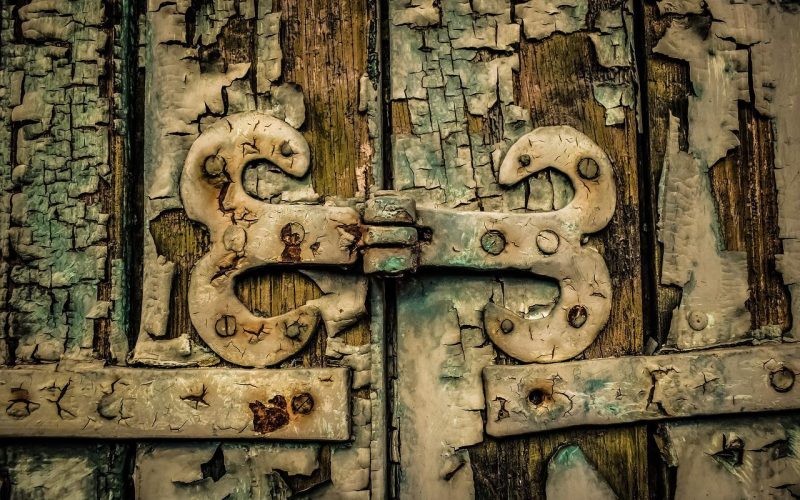Here’s a comprehensive list of the various types of door hinges you can use on your home’s exterior and interior doors.
Door hinges are a fundamental but underappreciated part of everyone’s daily routine. Closets, entryways, gates, kitchen cupboards, fireplaces, and even refrigerators will all have these small bits of hardware.
Door hinges are the hardware used to secure the door to its frame. They are the pivot point for the house’s door opening and shutting.
Hinges play a crucial function in keeping your door in its proper place, whether you’re installing a new door or replacing an old one.
Let’s discuss some types of door hinges that are available without further ado.
1. The Butt Hinge
The butt hinge is one of the different types of exterior door hinges. There are two identical leaves on these hinges. One of the leaves can move while the other remains still.
The leaves are then joined to a curled barrel, which allows the entrance to open. Furthermore, Butt hinges are popular because they can support a significant amount of weight.
Also, if you have a steel or fiberglass door, butt hinges are a good option because they can withstand much weight. Also, the extreme weight could destroy other hinges.
In addition, Butt hinges come in a variety of shapes and sizes. Installing and removing lift-joint butt hinges is simple. A rising butt hinge is designed for places with uneven floors.
Also, if your door is weighty, consider using a ball-bearing butt hinge. Butt hinges are one of the most prevalent types of exterior door hinges.
2. The Flush Hinge
Flush hinges are another popular choice, especially in tiny spaces. These hinges are made to be space-saving. One leaves compress against the other when the door is closed, saving space.
This type of hinge is extremely robust despite its small, compact form. However, they lack the strength of butt hinges, and if the door is too heavy, they will shatter.
These are an excellent alternative for holding a simple bedroom door in place, but they aren’t ideal for heavy front or exterior doors. A flush hinge is one of the different types of door hinges available.
3. Butterfly Door Hinge
This hinge style is trendy for interior doors because it is simple to install and has a great decorative design. It’s easy to see how this hinge earned its name: It resembles a pair of butterfly wings.
The design of the ‘winged’ section of these hinges can range from elegant and complex to plain. However, the butterfly door hinge is an excellent choice if you want to utilize a beautiful hinge on an internal door.
These hinges are unsuitable for external doors because they cannot support the weight of heavier doors. However, they are ideal for standard interior doors that are lightweight.
4. Double Action Spring Hinge
Saloon and cafe hinges are two types of internal door hinges that allow a door to open in both directions.
Because of the spring motion, the door will automatically close after being opened. This, however, makes it perfect for situations where the door should close behind someone once they have passed through it.
Commercial applications, such as store or restaurant doors, are the most prevalent uses for these hinges.
Furthermore, a double-action spring hinge is used on the kitchen door while waiting for staff to gain access behind the scenes at a cafe or restaurant.
This allows the employees to lean on the door and pass through while their hands are full from carrying plates or beverages.
Also, It means that the door closes after employees, preventing consumers from seeing into the kitchen for more than a second or two.
However, because the ability to open a door in either direction makes using a wheelchair much more accessible, these hinges can also be helpful in residential homes, especially where disabled persons live.
5. Ball Bearing Hinge
This is not the same as a ball-bearing butt hinge. A ball-bearing hinge is one of the most long-lasting choices available. This hinge is made to withstand the weight of large, heavy doors.
This hinge also has a ball bearing sandwiched between two knuckles. However, it is also known as the plain bearing hinge.
In addition, a ball-bearing hinge reduces friction between the two knuckles, which wears the hinge down over time.
These are usually used for entry doors, which are typically more significant and heavily used. Finally, a ball-bearing hinge reduces squeaking and friction by opening and closing smoothly. This is a fantastic hinge for a Gate.
6. Case Hinge
Butt hinges, and case hinges have a lot in common. As a result, they’re frequently used for front doors that are larger, wider, and heavier.
The most significant distinction between case and butt hinges is that case hinges are more fashionable, flashy, and attractive.
As a result, visitors and guests look excellent when they arrive through the door. Case hinges come in many shapes, styles, and colors and can even be found in suitcases. They can also be utilized as cabinet hinges for cabinet doors.
7. Hospital Hinge
Hospital hinges are the best option if you need a short hinge. This hinge is a fraction of the size of a butt hinge and was created with limited places in mind. One hinge leaf is attached to the door frame, while the other is attached to the door itself.
The rounded knuckle where these two leaves meet allows the door to open and close. This hinge is ideal for tiny places because it is compact and practical.
8. Take Apart Hinge
These hinges allow the door to be quickly removed and reattached. This could be beneficial if you have a tight entryway and frequently remove it to get furniture in and out.
All you have to do is remove the door from its position by pulling the middle pin in the hinge, and the door will be free to be put aside. Hold the door against the hinge and replace the center pin to replace it.
9. Bi-Fold Hinge
This is one of the different types of door hinges. This one allows the door to open in multiple directions. It has four pivot points, allowing for a more extensive range of motion.
These hinges are uncommon, yet they come in handy in certain instances. They’re ideal for closet or kitchen cupboard corner door systems where the door folds back and forth against itself to provide access to the internal cabinet. Also, they’re utilized on partition screen doors with concertina-style opening panels.
10. Concealed Hinge
Invisible hinges are another name for concealed hinges. Looking at a door from the outside, they are designed to be entirely covered.
However, they’re prevalent on closet doors and kitchen cabinet doors, especially in sleek modern designs where the hinge would detract from the doors’ seamless appearance.
The bracket and the pivot are the two main components of concealed hinges. Each piece is snapped into place after joining the door and the frame.
Also, These hinges allow the door to fit snugly into the frame while remaining unseen. They also include a wide-angle aperture that will enable them to open to a 90-degree angle.
11. Strap Hinge
This is one of the different door hinges people notice on open and closed gates. The most innovative choice on the market is the strap hinge.
They have the shortest hinge yet the most extended leaves of all the hinges. However, despite not being the most trendy, they are one of the most reliable door hinges.
Strap hinges are an excellent option for anyone looking for a unique look for their external door. You created the longer leaf to give the door more support than typical. As a result, strap hinges are popular for heavy-use doors, such as gates and the front entrance wing.
12. Olive Knuckle Hinge
The olive knuckle hinge is unique because it is shaped like an H. The hinge forms an “H” shape when the door is open.
The H hinge is another name for these hinges. Only the knuckle is visible when the door is closed. Moreover, The hinge’s design allows it to be used in various ways.
Olive knuckle hinges are commonly used on cabinet doors and outside doors. Because of the vast size, they’re incredibly robust and so lovely that you’d prefer a visible hinge to a hidden or semi-hidden hinge.
13. HL Hinge
The HL hinge is essentially a more durable version of the H hinge. The extra key is an additional supporting arm that connects to the front side of the door you’re latching, which is the different L shape that connects to the H.
However, this hinge is a fantastic choice if you need extra support for a massive wooden door. It’s also possible to add hinges to the bottom hinges, with the bottom front hinge being a G form that connects to the H shape.
14. Pivot Hinge
You created the pivot hinge with wider doors in mind. When a person has a larger door, keeping the door aligned with the wall and the floor can be difficult. The pivot hinge can help with this.
When the door opens, this hinge pivots, assisting in keeping the door in place. The appearance of a pivot hinge is similar to that of an olive knuckle hinge, but the operation is slightly different.
15. Heavy Duty Hinge
The name of this hinge is self-explanatory. The most significant difference between heavy-duty and standard hinges is that the latter are thicker.
It’s about a quarter-inch denser than a traditional hinge. In this sense, using heavier materials can create a heavy-duty hinge to fit the shape and function of any type listed.
A heavy-duty hinge is ideal for a large, heavy door used frequently. These hinges are excellent for more demanding applications, such as personal or bank safes.
16. Flag Hinge
Flag hinges get their name because the plate and shaft of the hinge are designed like two little square flags on a flagpole, with a twisting barrel connecting them in the middle.
One ‘flag’ will be attached to the door, while the other will be attached to the door frame. The center barrel will allow the door to move.
Furthermore, these are common outside hinges used on modern uPVC doors but can also be used on metal or hardwood doors.
Their appeal stems from how solid and secure they are. They are generally composed of solid metal, though they are frequently seen with a plastic covering to match the design of uPVC doors better. This is one of the different types of door hinges.
17. T Hinge
The T hinge is a cross between a strap and a butt hinge. They’re most commonly utilized with limited space, such as on frames and posts, shed doors, and tool chests.
The screw holes on each leaf hinge are staggered to distribute the strain and prevent the wood from splitting. These are typically found on gate doors, which give them a beautiful, rustic appearance.
18. Barrel Hinge
One of the more elaborate door hinge options is the barrel hinge. These are commonly used for tiny woodworking projects such as cabinets and jewelry boxes, although they are not used for huge doors.
Furthermore, Barrel hinges are usually constructed of pure brass. They’re appealing because they’re entirely hidden on both sides of the door, allowing it to open 180 degrees. Keep in mind that this hinge type is not intended for load-bearing applications.
19. Piano Hinge
The piano hinge earned its name because it was the first piano lid and seat door application. Nowadays, they are used to make workbenches, desks, cabinet doors, and storage boxes.
Also, see our article on How to Hide Cables in Your Home (39 Ways to Keep Them Out of Sight)
The piano hinge is a continuous hinge that runs the entire door length to which it is attached. It consists of two leaves of the same size joined by a central pin.








